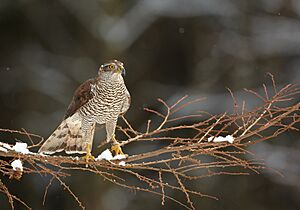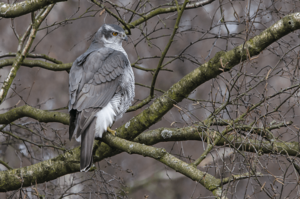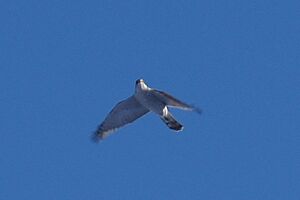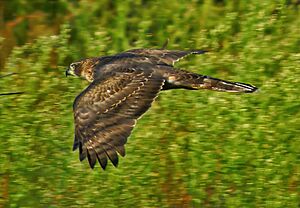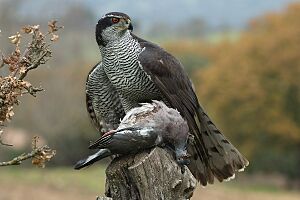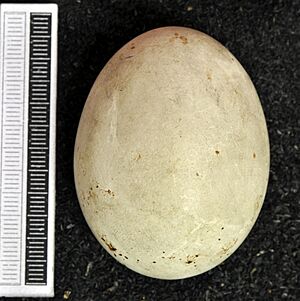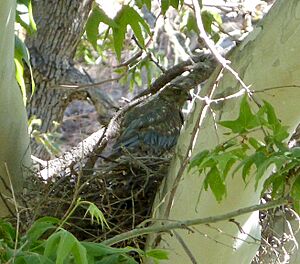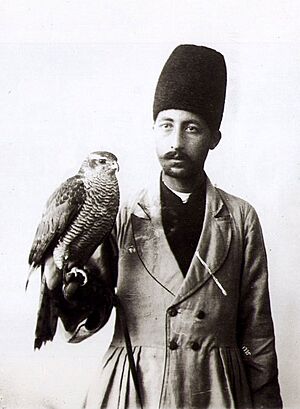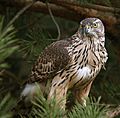Eurasian goshawk facts for kids
Quick facts for kids Eurasian goshawk |
|
|---|---|
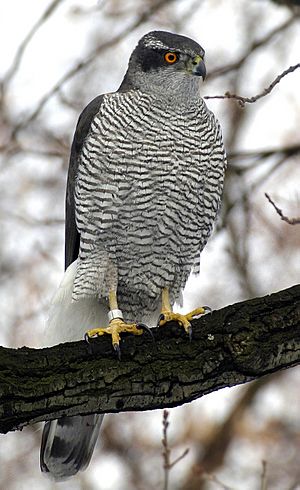 |
|
| Adult | |
| Conservation status | |
| Scientific classification | |
| Genus: |
Accipiter
|
| Species: |
gentilis
|
| Subspecies | |
|
|
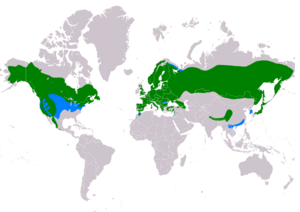 |
|
| Range of A. gentilis Resident Non-breeding | |
| Synonyms | |
|
Falco gentilis Linnaeus, 1758 |
|
The Eurasian goshawk (Accipiter gentilis) is a medium-sized bird of prey. It belongs to the Accipitridae family. This family also includes eagles and buzzards. Goshawks are often called "true hawks." Their scientific name comes from Latin. Accipiter means "hawk" or "to grasp." Gentilis means "noble" or "gentle." This is because in the Middle Ages, only noble people could hunt with goshawks.
Carl Linnaeus first described this bird in 1758. He called it Falco gentilis.
This bird lives in many temperate parts of Eurasia. It is the only "goshawk" in most of its range. So, people often just call it the "goshawk." Most goshawks stay in one place. But birds from colder areas fly south for winter. As of 2023, goshawks in North America are now a different species. They are called the American goshawk.
Contents
Where Do Goshawks Live?
The Eurasian goshawk lives across Eurasia. You can find them in most parts of Europe. This excludes Ireland and Iceland. They are common in Russia, except for the treeless tundra. In the south, they live in Morocco, Turkey, and parts of India and Japan. In winter, some fly as far south as Saudi Arabia and Vietnam.
Sometimes, goshawks are seen in places like Alaska or North Africa. These are usually birds that have wandered far from home. The goshawk is also the state animal of Punjab, India.
What Kind of Home Do Goshawks Like?
Eurasian goshawks live in both deciduous (trees that lose leaves) and coniferous (evergreen) forests. They don't seem to prefer one type of tree over another. In central Europe, they can even live in small woods near cities. They might use isolated trees in city parks.
Goshawks are shy of people. But they do live in some large cities like Berlin and Hamburg. This is a new trend that started in the 20th century.
Goshawks can live at almost any height. But they are often found in high elevations. This is because most large forests in lower areas are gone. They can live up to the tree line on mountains. In winter, birds from northern or high mountain areas move to warmer forests. Most goshawks stay in their home areas all year.
What Does a Goshawk Look Like?
The Eurasian goshawk has short, wide wings. It also has a long tail. This helps it fly easily through forests. It has a fairly large beak and strong, short legs. Its toes are very thick.
Most goshawks are blue-grey or brownish-grey on top. Their undersides are grey or white with dark stripes. Asian goshawks can be very pale or almost black. Goshawks from colder areas are usually paler. Older birds may also become paler.
Young goshawks are usually brown on top. Their undersides can be white or have broad brown stripes. Both young and adult goshawks have a barred tail. It has 3 to 5 dark bars.
Adults always have a white stripe above their eyes. This stripe is wider in northern birds. In Europe and Asia, young birds have pale-yellow eyes. Adults usually have orange eyes.
Goshawks change their feathers (moult) from late March to May. Females moult later and faster. This can make it harder for them to hunt. It can also make them vulnerable when they are sitting on eggs. The moult takes 4–6 months.
The Eurasian goshawk is the largest bird in its group, Accipiter. Female goshawks are much bigger than males. This is called sexual dimorphism. Males are about 8% smaller in North America. In Eurasia, they can be 13% smaller. Sometimes, the difference can be as much as 28%.
Male goshawks are about 46 to 63 cm (18 to 25 in) long. Their wingspan is 89 to 122 cm (35 to 48 in). Females are larger, 58 to 69 cm (23 to 27 in) long. Their wingspan is 108 to 127 cm (43 to 50 in).
Males weigh around 762 g (1.7 lb). Females can weigh more than twice as much, around 1150 g (2.5 lb). Some large females can weigh up to 2200 g (4.9 lb).
What Sounds Do Goshawks Make?
Goshawks usually make sounds only during courtship or nesting. Adult goshawks make a repeated chattering sound. The speed and loudness change based on the situation.
Males make a fast, high-pitched kew-kew-kew when bringing food. They also make a croaking guck or chup sound. This sound is made when a male meets a female.
Female goshawks make a rapid, loud kek-kek-kek sound. This means they are alarmed or want to chase away an intruder. They do this when chasing predators like great horned owls. Males respond to intruders with a quieter gek gek gek.
Sometimes, hunting goshawks make shrill screams. This happens when they chase prey for a long time.
Are There Similar Birds?
Young goshawks can look like other young Accipiter birds. But adult goshawks never have a rusty color on their undersides. In Eurasia, a smaller male goshawk might be confused with a female Eurasian sparrowhawk. But goshawks are much bigger and bulkier. They also have longer, more pointed wings.
Sparrowhawks often flap their wings a lot when flying. Goshawks have deeper, slower wing beats. Goshawks can also soar steadily, which smaller hawks usually can't do.
Goshawk Family Tree
The Accipiter group has almost 50 living species. It's the most diverse group of daytime raptors. These agile, forest-dwelling hawks have been around for millions of years. This helped them adapt to the many small birds in forests.
The Eurasian goshawk is part of a "superspecies" group. This group includes other large goshawks from around the world. The American goshawk was once thought to be the same species. But now it's considered separate.
The name goshawk comes from Old English. It means "goose-hawk." This name suggests they are good at hunting large birds like geese.
Different Kinds of Goshawks (Subspecies)
Goshawks have spread across northern and central Eurasia. They moved west into Europe and east into North America. Fossils show they were in California a long time ago.
Goshawks vary in color and size. This is because they adapted to different areas. There are many different types, or subspecies, of goshawks. Most experts agree on 9 to 10 subspecies.
- European Goshawk (A. g. gentilis): This is the most common type in Europe. It's a large subspecies. Females are much larger than males. They are usually dark brown on their backs. Their heads are blackish-brown. Their undersides are creamy with heavy dark stripes.
- Sardinian/Corsican Goshawk (A. g. arrigonii): This smaller type lives on the islands of Sardinia and Corsica. It's more blackish-brown on top. Its underside is almost pure white with black stripes.
- Siberian Goshawk (A. g. buteoides): This large type lives from northern Fennoscandia to western Siberia. Many fly south for winter. They are usually paler than the European type. They are blue-grey on top with a wide stripe above the eye. Their undersides are white with fine dark stripes.
- Northeastern Siberian Goshawk (A. g. albidus): Found in northeastern Siberia and Kamchatka. Many fly south for winter. This is the palest type of goshawk. Many are pale grey with lots of white on their heads. About half are almost pure white.
- East Asian Goshawk (A. g. schvedowi): This type lives from the Ural mountains to Japan. It's smaller than other mainland types. Its wings are shorter and feet are smaller. It's slate-grey on top with a blackish head. Its underside has thin brown stripes.
- Japanese Goshawk (A. g. fujiyamae): Found in Japan. It's a fairly small type. It's darker slate on top. It has heavier stripes below. It's probably the darkest type on average.
How Goshawks Behave
Protecting Their Home (Territoriality)
Goshawks are usually alone or in pairs. They are very territorial. This means they protect their home area. Adults show off their territory by flying in special ways. During nesting, a pair's home area can be very large. They defend it strongly to protect their nest and food.
Display flights happen most of the year. They are most common from January to April. Goshawks may fly slowly with deep wing beats. They might also glide and undulate. They often try to scare away other goshawks without fighting. If another goshawk doesn't leave, the defending bird might fly more aggressively. Sometimes, fights can happen, and birds can get hurt.
Do Goshawks Migrate?
Goshawks are "partial migrants." This means some move, and some don't. They usually move between September and November in the fall. In spring, they move from February to April. Some birds stay in their territory all winter.
Northern goshawks from northern Fennoscandia have flown up to 1640 km (1019 mi). But adults usually stay closer to their summer homes. Young birds often fly further away. Goshawks seem to avoid flying over large bodies of water.
What Do Goshawks Eat?
How Do Goshawks Hunt?
Goshawks have short wings and long tails. This helps them fly quickly and twist through dense forests. They are powerful hunters. They catch birds and mammals in forests and open areas. They often use speed and cover to surprise their prey.
Goshawks often hunt near the edge of forests and meadows. They usually hunt from a perch. They fly quickly and low to the ground. Then they stop and look for prey from a high spot. These flights are meant to be quiet. If prey sees them too soon, they might give up the chase.
Sometimes, goshawks watch for prey from high in the sky. But most of the time, they hunt from perches. In cities, they might hunt pigeons from high up.
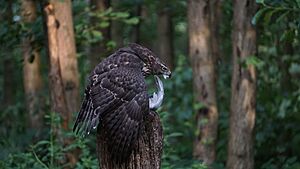
Once a goshawk picks its prey, it might chase it. Goshawks can fly very fast horizontally. They can reach speeds of 38 mph (61 kph). They are described as "reckless" and "fearless" when chasing prey. They will chase prey through almost any conditions. They have even been seen running on the ground into thick bushes. They might even chase domestic animals into barns or houses.
Chases can be long, up to 15 minutes for a squirrel or hare. Sometimes, a pair of goshawks will hunt together. One distracts the prey, while the other ambushes it. When gliding down to catch prey, a goshawk might not even flap its wings. This makes its flight almost silent.
Goshawks kill prey by squeezing it with their talons. They often eat their kills on the ground. Breeding goshawks might take prey to a low perch. They use "plucking perches" to remove feathers or fur. Goshawks often leave more uneaten parts of their prey than other raptors. This helps identify their kills.
A goshawk needs about 120 to 150 g (4.2 to 5.3 oz) of food per day. Most kills can feed a goshawk for 1 to 3 days. They sometimes hide food in trees for later. This is common when they have young. Goshawks are successful in about 15–30% of their hunts.
What Do Goshawks Like to Eat?
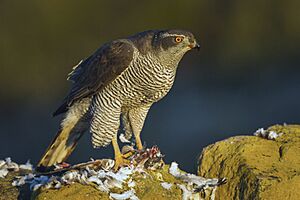
Goshawks eat what they can find. Their main prey are small to medium-sized mammals and medium to large-sized birds. These animals live in forests and open areas. What they eat can change a lot depending on the region.
Birds are usually the main food in Europe. Mammals are less common. Goshawks often choose young prey in spring and summer. This is because young birds and mammals are easier to catch.
A goshawk's typical prey weighs between 50 and 2000 g (1.8 oz and 4.4 lb). Males usually catch smaller prey than females.
Crows and Jays
One common prey family is corvids (crows, jays, magpies). The Eurasian jay is often a main food source in Europe. These jays are loud and fly slowly, making them easy targets. Eurasian magpies are also common prey.
Some people think goshawks rarely hunt large crows. This is because crows are smart and can mob predators. But many goshawks do hunt crows. Sometimes, goshawks even trick crows into coming closer.
Pigeons and Doves
In Europe, the rock pigeon is often the main prey. This is especially true in cities where goshawks live. Even in forests, goshawks hunt these pigeons. They also hunt the larger common wood pigeon.
Goshawks often pick out oddly colored pigeons from a flock. This preference is stronger in older, more experienced goshawks.
Gamebirds
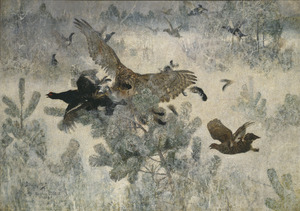
In some areas, goshawks specialize in hunting gamebirds like grouse. Gamebirds usually stay on the ground. This makes them easy for goshawks to catch if they are not seen. If they fly, the chase is harder.
In Scandinavia, forest grouse are important prey. This includes the black grouse and hazel grouse. Goshawks can have a big impact on grouse populations. They often catch young grouse.
Female goshawks sometimes catch larger male gamebirds. This is because males are bigger and have better defenses. Male goshawks can catch black and hazel grouse of any age. But they can only catch female capercaillie. Adult female goshawks have been seen killing male capercaillie, which are much larger.
Goshawks also sometimes hunt domestic fowl, like chickens. This happens more often when wild prey is scarce.
Squirrels
Squirrels are the most common mammalian prey. Goshawks are very good at hunting tree squirrels. They are strong enough to catch even the largest squirrels. They are also more agile than other hawks. The red squirrel is the most common mammal prey in Europe.
Hares and Rabbits

Goshawks can also hunt many types of lagomorphs (hares and rabbits). In the Iberian peninsula, the European rabbit is often a main food source. Most rabbits caught are young ones.
In snowy areas, larger hares are hunted. These are harder to catch but provide a lot of food. Female goshawks in Fennoscandia often catch mountain hares. These hares can be up to 2.4 times the goshawk's own weight.
Other Birds
Goshawks hunt many other birds. They often catch woodpeckers. Woodpeckers fly slowly, making them easy targets. They also live in the same areas as goshawks.
Goshawks also hunt water birds like ducks. The mallard is a common duck they catch. They rarely hunt geese, even though their name means "goose-hawk." But they have been known to catch large geese.
Smaller songbirds are sometimes eaten, especially thrushes. The Eurasian blackbird is often caught. Goshawks usually ignore very small birds. But they have been known to catch birds as small as the goldcrest.
Other Mammals
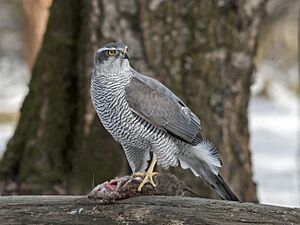
Goshawks sometimes eat other rodents, but not as often as squirrels. They also eat small insectivores like moles and shrews. The smallest mammal they've been known to catch is the masked shrew.
Small carnivores like weasels and martens are also hunted. Rarely, they might catch young dogs or cats. They have even been seen catching a young monkey. Goshawks might also eat dead deer or sheep.
Who Else Hunts Goshawks?
Goshawks are usually at the top of the food chain in forests. But they still face threats from other predators. The most dangerous are likely the Eurasian eagle owl and the great horned owl. These owls hunt goshawks of all ages. They also take over goshawk nests.
Other large raptors can also kill goshawks. This includes golden eagles and bald eagles. Sometimes, other birds like white-tailed eagles or red-tailed hawks also kill them.
Mammals can also be predators. Fishers are a main cause of death for young goshawks in some areas. Pine martens also prey on young goshawks in their nests. Other tree-climbing mammals like wolverines and raccoons can also attack nests.
Young goshawks are also vulnerable to canids like coyotes and red foxes. This is because young goshawks perch lower and are less careful.
Sometimes, goshawks are killed by non-predators. This can happen if prey fights back. Or they might have hunting accidents. For example, a goshawk drowned trying to catch a duck. Another was torn in half by a large hare it caught.
Goshawk Life Cycle and Reproduction
Goshawks are one of the most studied raptors for their breeding habits. Adults return to their breeding areas between March and April. Sometimes, they stay all year if there's enough food. Most breeding happens from April to July.
Courtship flights happen on sunny, calm days in early spring. Males often bring food to the female. This shows their health and hunting skills. Both birds usually call during mating.
Goshawks often use the same mate for many years. Males are sometimes killed by females during courtship if they don't bring food.
Where Do Goshawks Build Nests?
Goshawks may use the same nest for several years. Or they might build a new one. Males build most new nests. Females might help reinforce old ones. They often choose the tallest tree in an area. They use many types of conifer and broadleaf trees.
Nests are usually built under the tree canopy. In North America, nests are 5.8 to 16.9 m (19 to 55 ft) high. In Europe, they are 9 to 25 m (30 to 82 ft) high. In very short trees, nests can be as low as 1 to 2 m (3.3 to 6.6 ft) off the ground.
New nests are about 80 to 120 cm (31 to 47 in) long. They are 50 to 70 cm (20 to 28 in) wide. After many uses, a nest can be 160 cm (63 in) across and weigh a ton when wet. Goshawks sometimes use nests built by other birds.
A pair might have several nests. They often switch between them each year. This might help reduce parasites. Nests are usually not found near forest edges. Active nests from different pairs are usually at least 600 m (2000 ft) apart.
Goshawk Eggs
Goshawks lay eggs every 2 to 3 days. This usually happens between April and June. A clutch of 3–4 eggs takes up to 9 days to lay. The eggs are rough and pale bluish or dirty white.
Eggs average about 57 to 59 mm (2.2 to 2.3 in) tall and 44 to 45 mm (1.7 to 1.8 in) wide. The largest eggs are found in Lapland, Finland. Eggs weigh around 50 to 63 g (1.8 to 2.2 oz).
Most clutches have 2 to 4 eggs. Sometimes, there is only 1 egg, or as many as 5–6. The number of eggs depends on the spring weather and food supply. If all eggs are lost, the female can lay a new clutch within 15 to 30 days.
Parenting Behavior
Females become quieter during incubation. They turn the eggs often. Males incubate for 1 to 3 hours early on. But females do most of the incubation, up to 96% during the day. Incubation lasts 28 to 37 days.
After hatching, the male brings food to a branch near the nest. The female tears it apart and feeds herself and the young. Food deliveries can be daily or every 3 to 5 days. The female needs to feed the young about twice a day.
In Europe, female goshawks might stay on the nest if a human approaches. Or they might leave quietly. In North America, parents often fiercely defend their nests. They will make loud calls and swoop at intruders. This can cause minor injuries. Females do most of the attacks on humans.
Sometimes, parents abandon the nest. If the female leaves or dies, the male might try to raise the young. But usually, they starve without the female's help. If the male leaves, the female might raise one chick.
Hatching and Growing Up
Eggs hatch over 2 to 3 days. Young goshawks are born with down feathers. They grow quickly. They are about 13 cm (5.1 in) long at first. They grow 5 to 9 cm (2.0 to 3.5 in) each week.
Mothers brood the nestlings for about two weeks. At three weeks, young can stand and start to grow flight feathers. They reach half the adult weight. Females start to grow faster than males. This stage needs more food, so parents spend less time at the nest. This can lead to more predation.
At four weeks, young have strong flight feathers. They can start to pull on food. By the fifth week, they act more like goshawks. They might "play" by grabbing branches. By the sixth week, they start to move onto branches near the nest.
Young goshawks usually leave the nest when they are 35 to 46 days old. They take their first flight about 10 days later. Young goshawks sometimes push aside their younger siblings. This can lead to younger ones starving or being killed by siblings. This is called "siblicide."
At about 50 days old, young goshawks might start hunting. But they often eat food from their parents. Most stay near the nest until they are 65 days old. They become fully independent between 65 and 90 days old. Young birds seek independence on their own.
How Successful Are Goshawks at Breeding?
Most nests (80-95%) produce young. An average nest produces 2 to 3 fledglings. About the same number of eggs and nestlings are lost. Larger clutches (4 to 5 eggs) have higher losses.
Poor weather, like cold springs, can cause nests to fail. But the main reasons for nest failure are human actions and other predators. Low food supplies can also lead to more predation.
Older, more experienced pairs are more successful. Males usually don't breed before 3 years old. Females can breed at 1 to 2 years old. But they rarely have successful clutches that young. The peak breeding years are 6–9 years old.
How Long Do Goshawks Live?
In captivity, goshawks can live up to 27 years. In the wild, birds that survive their first two years can live up to 11 years. One goshawk was recorded living for over 16 years.
Starvation causes some deaths, especially in young birds. Diseases can also kill goshawks. Some goshawks die from flying into power lines or buildings. Cars also cause deaths.
Goshawk Conservation Status
The Eurasian goshawk lives across a huge area. This includes over 30 million square kilometers (11.5 million sq mi). In Europe, there are 3–5 pairs per 100 square kilometers (39 sq mi). The total world population is probably over a million birds.
In Europe, the goshawk is the fourth most common raptor. There are about 160,000 pairs. Sweden, Germany, and Finland have the most goshawks.
Mortality rates are higher for first-year goshawks. In some studies, 40–42% of first-year birds died. For adults, 15–21% die each year.
In the past, goshawk populations decreased. This was due to hunting, disturbance, and habitat loss. From 1880 to 1930, thousands were killed each year in Norway. Hunting rates have since lowered.
Pesticide pollution also caused declines in the 1950s–1960s. DDT caused a huge crash in the Netherlands. Mercury seed dressings also harmed goshawks in Scandinavia.
Today, deforestation is a main threat. Logging can destroy nests and harm local populations. If too much forest canopy is removed, goshawks might leave the area. However, European goshawks can adapt to some habitat changes.
Goshawks and People
Goshawks in Culture
The northern goshawk appears on the flag and coat of arms of the Azores. The islands were named after the Portuguese word for goshawk (açor). The explorers thought the birds they saw were goshawks. But they were actually kites or common buzzards.
Hawks are important to Guru Gobind Singh in the Sikh community. He is believed to have kept a white Northern Goshawk. This is why the Northern Goshawk is the official state bird of Punjab, India.
Goshawks in Falconry
The name "goshawk" comes from "goose hawk." This means they are good at hunting large birds like wild geese. But in falconry, goshawks traditionally hunt rabbits, pheasants, and medium-sized waterfowl. In Japan, goshawks were used to hunt geese and cranes.
In old European falconry books, goshawks were called a "yeoman's bird." This means they were useful for catching edible prey. They were not just for noblemen like the peregrine falcon. Today, the northern goshawk is still very popular in modern falconry.
When hunting with a falconer, the goshawk chases prey from the falconer's hand. They fly very fast. If the prey is a bird, the goshawk might flip over to grab it from below. Goshawks will follow prey into thick bushes. They even chase prey on foot.
Goshawks trained for falconry sometimes escape. Many of these escaped birds survive. They can even breed in the wild.
Images for kids
-
Chasing an osprey, most likely to rob it of food, but the osprey is even considered possible prey
-
Juvenile goshawk from Poland
See also
 In Spanish: Azor común para niños
In Spanish: Azor común para niños



